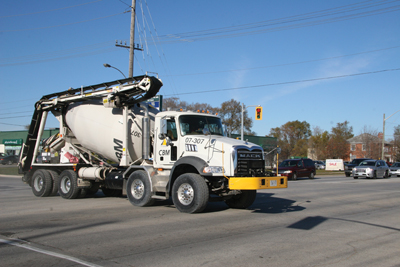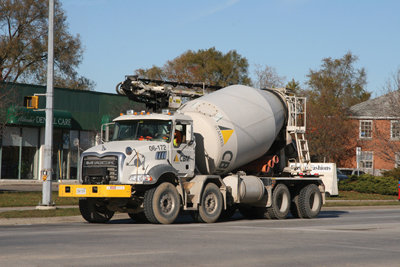
Features
Roads & Paving
Technology
Automated error detection improves concrete delivery
January 12, 2010 By Aggregates
With more than 400 ready-mix concrete trucks on the road at any given
time, St. Marys Canada Building Materials (CBM) relies on real-time
data transmitted from those vehicles to its fleet management software
to meet customers’ construction schedules.
With more than 400 ready-mix concrete trucks on the road at any given time, St. Marys Canada Building Materials (CBM) relies on real-time data transmitted from those vehicles to its fleet management software to meet customers’ construction schedules. An automated event log monitoring system detects error conditions in that critical data flow, thereby helping to ensure that concrete arrives at customer jobsites when construction workers are ready to pour.
 |
|
| With over 400 ready-mix concrete trucks on the road at any given time, St. Marys Canada Building Materials (CBM) relies on real-time data transmitted from the trucks to its fleet management software to meet customers’ construction schedules.
|
Eric Epstein, a CBM production systems analyst, explains that any prolonged disruption in the data stream can force a switch to manual vehicle tracking that is both less efficient and less accurate. In 2007, the company began using a business process automation platform to help maintain the data flow by monitoring the Windows Event Log for error conditions. When errors are found, designated personnel are alerted by email. This strategy, accomplished with no coding, has shortened outages and saved headaches for dispatchers and plant managers.
The challenge
St. Marys CBM, a division of St. Marys Cement Inc., serves the Ontario market from 40 plants, located in areas from Hull, Quebec (serving the National Capital region) in the east, over 750 km to Windsor in the west and concentrated in the most heavily populated areas of the province. Each truck dispatched from those plants is a mobile mixing machine delivering made-to-order concrete. On-time delivery is essential to ensure that the concrete maintains the proper consistency as well as to avoid causing construction delays.
The company uses Command Alkon’s COMMANDconcrete software to track vehicle location and deploy trucks to the right place at the right time. If the network goes down or a virtual serial device driver or receiver at a given plant fails, dispatchers lose automatic visibility into truck locations. Timely knowledge of a communications breakdown or malfunction in the vehicle radio transmitter is needed to minimize outage duration, but it used to be hard to come by. “We wouldn’t know about a problem until the plant or regional manager called us about it,” said Eric Epstein, a CBM production systems analyst.
Epstein wrote a custom application that records a variety of communications-related problems to the Windows Event Log to flag problems in near-real-time, but manually checking the log on six different servers on a continuous basis was not a practical alternative. He needed a way to automatically monitor the activity and trigger an email when a problem occurred. Writing a DOS batch file for that purpose would have been difficult, taken several days, and required additional third-party tools that would in turn have had to be configured and maintained. As it turned out, a better option was to hand.
The solution
Another St. Marys department had begun using Network Automation’s AutoMate Professional business process automation platform a year earlier to transfer files between the company’s production and accounting systems. From that team, Epstein discovered that automation routines could be built using pre-programmed tasks and drag-and-drop workflow assembly, triggered by time or event, and executed with the same tool – all without the time or expense of writing batch files or custom scripts.
 |
|
| An automatic data error reporting system has shortened outages in the company’s vehicle tracking system and saved headaches for dispatchers and plant managers.
|
“The library of functionality available in AutoMate is significantly more comprehensive than what’s available in a traditional DOS file, and I could do what I needed to do 10 times faster,” Epstein noted. With the same AutoMate licence that had already been purchased and used by St. Marys’ IT team, Epstein spent just 20 minutes compiling his own automation sequences using the software’s Event Log trigger and pre-programmed “Send email” command. He simply dragged and dropped the instructions into the AutoMate task-building window, setting the stage for AutoMate to continuously poll the Windows event viewer on all six servers for pre-defined error entries and email CBM’s production systems team whenever those conditions arise.
Today, AutoMate detects network, serial driver and receiver malfunctions that interrupt data flow to the company’s COMMANDconcrete software. It also finds message delays indicating radio transmitter trouble; duplicate vehicle identification numbers caused by moving radio transmitters between vehicles and more. No manual parsing of COMMANDconcrete’s log files or the Windows Event Log is required.
Epstein adds that the system’s ability to help quickly uncover and communicate vehicle tracking problems has also prevented small IT problems from escalating into large ones. In addition, troubleshooting is faster as log files no longer have to be checked manually. The system also functions as a kind of fail-safe system against communication interruptions and has increased dispatcher confidence in CBM’s fleet management software.
In practice, emails triggered by the system indicating that something has gone wrong arrive on a daily basis. “Often,” says Epstein, “it’s a minor issue that can be resolved simply by restarting the serial link software, but every minute we shave off an outage in our vehicle tracking system can make a difference in keeping our operations running smoothly.”
Print this page